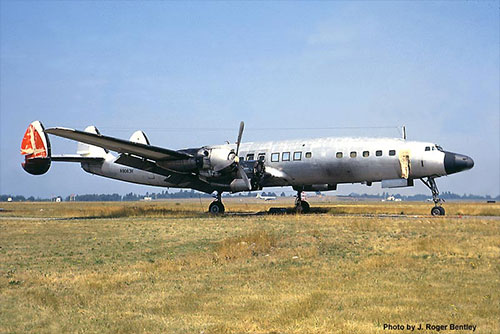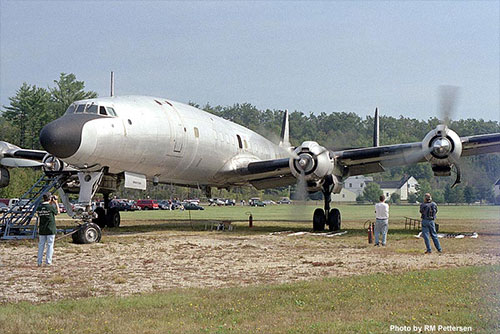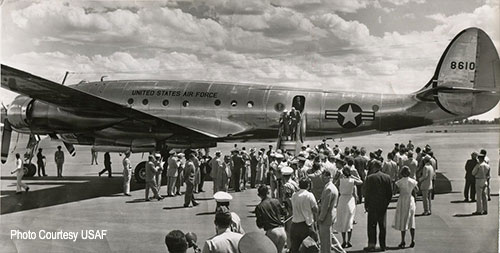
Historic plane to be NY hotel lounge60 year old Constellation flew in Alaska, made drug runs elsewhereBy DAVE KIFFER
November 07, 2018
The Constellation - N8083H - has been out of service for more than 30 years and had spent the last three decades at an airport in Maine being cannibalized for the restoration of another old "Connie." But recently, N8083H made the 300-mile trip to New York, on the road. It is now being restored adjacent to the soon to open TWA Hotel at JFK, which itself is a repurposing of the legendary "space age" TWA Terminal. The Constellation will become a lounge and "passenger event" space next to the hotel.
Many airline enthusiasts consider the Lockheed Constellation to be one of the high points of the romantic propeller airline age, even as it was being overtaken by the jet age in the late 1950s. The Constellation looked unlike any thing else in the air. The four-engine plane had a distinct triple "tail" with three vertical stabilizers rather than one. The three smaller stabilizers cut down on the height of the aircraft significantly. allowing it to fit inside many existing airport hangers. The fuselage was not straight, but actually rose with a slight hump between the front and the back of the plane. Some likened its "line" to that of a dolphin. The "humped" fuselage was more expensive to build that the tube shapes of the other airlines, even though it was purported to help the plane's aerodynamics. The Constellation was developed in the late 1930s when American airlines were looking to expand their cross-country flights and wanted planes that would either need fewer stops or eliminate them altogether. Howard Hughes at Trans-World Airlines (TWA) specifically asked Lockheed to develop an airliner that could carry 40 passengers with a range of 3,500 miles. According to common legend Hughes designed the Constellation but that was not true, he only provided Lockheed with the parameters of 40 passengers and 3,500 miles, according to aviation historians. The Constellation was the source of many legends over the years. But it was not the first plane with a pressurized cabin and it was not the fastest four engine plane of its time. Perhaps most unfair was that humorists dubbed it the best "tri--motor" airliner ever developed because at least one the four 18-cylinder Wright Cyclone engines was always "cutting out." Overall, the engines on the Connie were no less reliable than those on other airliners of the time.
One "legend" about the Connie was true, though. Apparently, a passenger did become stuck to a toilet seat once by cabin pressurization. "Stories of this happening on modern jets are urban legends, but Connies had far more primitive potties," Stephan Wilkinson wrote in the June, 2016 edition of Aviation History Magazine. "When the valve that emptied the toilet into the unpressurized reservoir failed on one airline flight, the poor lady who happened to be in the blue room at the time became the cork that maintained cabin pressure. She was freed when the crew depressurized the airplane." The Constellation was based on the design of another distinctive plane with multiple horizontal stabilizers, Lockheed's own World War II fighter, the P-38 Lightning. During WWII, the Constellations were used primarily for cargo transportation in the war effort. After the war, the Connie's cruising speed of 340 mph put it at the forefront of planes on transcontinental routes. It also proved valuable on opening up the trans-Atlantic routes because its 3,500 mile range meant that it could easily fly from New York to Gander, Newfoundland and from Gander to Shannon in Ireland and then on to Europe.
The plane's range also made it a safe bet to cross the distances between the few land airports in Alaska in the 1950s. Airlines like Alaska AIrlines and Pacific Northern Airways bought several Constellations for their routes. Overall, more than 850 Connies were built at Lockheed's Burbank, California factory between 1943 and 1958. Unfortunately, even the Constellation could not help Lockheed wrest control of the domestic market from Douglas which continued to dominate U.S. airliner sales until Douglas itself was overwhelmed by the jets of Boeing in the early 1960s. The Constellations were more expensive to build than their competitors and as newer prop jets hit the market, the older Connies became more expensive to operate. N8083H was one of the last Constellation's made, coming off the line in 1957, destined for Italian airline LAI. But it was never picked up and remained at Lockheed until 1958 when it was purchased by TWA. TWA operated the passenger plane until December of 1960. By then jets like the Boeing 707 and the Douglas DC- 8 were dominating the industry and prop jets were being retired or being converted into cargo planes. The latter was N8083H's fate. By March of 1961, the plane was being used as a cargo freighter by TWA. Then its history became a lot more interesting. Alaska Airlines first leased and then purchased N8083H. It flew from one end of Alaska to the other delivering cargo from 1962 to 1967. Although it was primarily used in northwest Alaska, it also frequently made runs between Seattle and Annette Island and the rest of Southeast. Alaska took it out of service in May of 1967, but then converted it into a bulk oil carrier. The plane then began a peripatetic flight path for the next decade between several smaller Alaskan carriers including Red Dodge Aviation, Prudhoe Oil Distributing Company, Interior Airways, Westair, Onyx Aviation and Burns Aviation. Eventually, it ended up in Arizona in 1981, where it was reconfigured to ferry large bales of marijuana in Central and South America for the next two years. Eventually, it was abandoned in Colombia, stuck in the mud at a remote airfield. In 1986, it was purchased by Maine Coast Airways, rehabilitated and flown to the Auburn-Lewiston Airport. The company decided that the plane was too expensive to make airworthy, so it began restoring it for display. Eventually it and two other planes were purchased by the German airline Lufthansa, also for restoration, But project delays kept N8083H in Maine for several more years. Finally, it was purchased by the hotel developers last year. The hotel is scheduled to open in March of 2019. https://www.twahotel.com/hotel
On the Web:
Contact Dave at dave@sitnews.us Dave Kiffer ©2018 Publication fee required. © Representations of fact and opinions in comments posted are solely those of the individual posters and do not represent the opinions of Sitnews.
|
|||||


